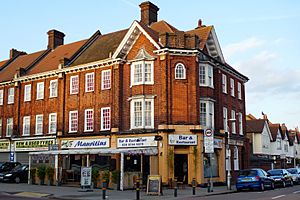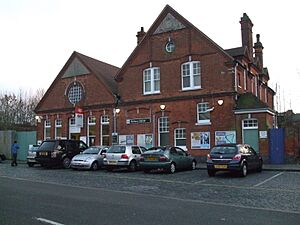Norbury facts for kids
Quick facts for kids Norbury |
|
|---|---|
 |
|
| Population | 16,476 (2011 Census. Ward) |
| OS grid reference | TQ315695 |
| London borough | |
| Ceremonial county | Greater London |
| Region | |
| Country | England |
| Sovereign state | United Kingdom |
| Post town | LONDON |
| Postcode district | SW16 |
| Dialling code | 020 |
| Police | Metropolitan |
| Fire | London |
| Ambulance | London |
| EU Parliament | London |
| UK Parliament |
|
| London Assembly |
|
Norbury is a busy area in South London. It shares its postcode, London SW16, with nearby Streatham. Norbury is about 6.7 miles (10.8 km) south of Charing Cross, which is often seen as the very center of London.
Contents
What's in a Name? The Meaning of Norbury
The name Norbury comes from "North Burh". A "burh" was an old English word for a fortified town or borough. Some local stories say Norbury got its name because it was on the northern edge of the old Manor of Croydon. Other stories suggest it came from a split in an older area called Bensham. "Northbenchesham" became Norbury, and "Southbenchesham" later became Thornton Heath.
Norbury's Past: A Look Back in Time
For a long time, Norbury was mostly quiet countryside. A famous Roman road, the London to Brighton Way, passed right through it. In 1961, parts of this 32-foot-wide road were found near Hepworth Road. Further south, at Hermitage Bridge, people found what was left of a metal ford across the River Graveney. This river helps form the border between Norbury and Streatham.
Norbury Manor: A Medieval Estate
By the early 1200s, Norbury was a smaller part of the larger Croydon manor. The first time Norbury Manor was written about was in 1229. At that time, it was described as "lands stretching out either side of the London Road." In 1269, the manor included many different types of land. There were fields for growing crops, pastures for animals, heathland, woodlands, and meadows.
In 1337, the Norbury Manor was given to Nicolas de Carew. His family also owned the nearby Beddington Manor. The Carew family stayed in charge of Norbury Manor until 1859. Norbury remained a farming area throughout this time. By 1800, most of the land was owned by just a few people. The Carew family owned about half of it.
Victorian Norbury: Growing Up
At the start of the Victorian era, Norbury was very small. Only 56 people lived there, in three main homes: The Hermitage, Norbury Manor Farm House, and Norbury Hall. The Hermitage was a house near Green Lane. A famous music hall performer named Jenny Hill lived there in the 1890s. In 1894, a golf club was built on the land behind The Hermitage. They bought the house to use as their clubhouse, but it burned down in 1897.
Norbury Manor Farm House was the original manor house until Norbury Hall was built in 1802. The Farm House was taken down in 1914. Today, only Norbury Hall remains. It is now a retirement home and is a Grade II listed building, which means it's an important historical building.
In 1859, the first modern house, Norbury Villa, was built on London Road. More large houses followed along the road. In 1867, horse races started at Lonesome Farm. These races were very popular and brought many people from London. To help with the crowds, Norbury railway station opened in 1878. However, the large crowds also caused problems. Local people asked politicians to stop the races. In 1879, a new law banned horse racing within ten miles of Westminster, which ended the Streatham Races.
Norbury Becomes a Town
By 1900, Norbury was a nice, partly rural suburb. It had two golf courses and clubs for cricket, football, tennis, and bowls. The first shops on London Road were built in 1900. New roads for houses also started to appear. Electric trams arrived in 1901, connecting Norbury to Purley. However, people traveling to London had to change trams in Norbury because the tram systems were different.
Over the next 30 years, most of Norbury's houses were built. One important housing area was the Norbury Cottage Garden Estate. It was built in 1901 and was the first "cottage estate" built by the London County Council. Norbury's population grew a lot during this time. It went from 475 people in 1901 to 15,538 by 1931.
In the second half of the 1900s, many of the big Victorian houses were taken down. Office buildings were built in their place. Later, many of these office buildings were turned into apartments. In 1970, Norbury Fire Station was built.
Norbury Today: A Modern Community
Today, Norbury is a busy residential area. It has a diverse community with people from many different backgrounds. The main street, Norbury High Street, has many local shops, newsagents, and a few pubs. Norbury is also well-connected to other areas like Crystal Palace, Croydon, and Central London. Norbury Station is in fare zone 3 for public transport. Some local people feel the area is facing challenges, like litter and anti-social behavior. A campaign has started to help improve things.
Who Lives in Norbury? A Look at the Population
The 2011 census showed that Norbury is a very diverse place.
- About 37.4% of people were White or White British.
- About 28% were Asian or Asian British.
- About 24.8% were Black or Black British.
- About 6.5% were from Mixed/multiple ethnic groups.
The most common place of birth for people living in Norbury is England (55%). Other common birthplaces include India (5%), Pakistan (4%), Jamaica (4%), and Kenya (2%).
Most people in Norbury speak English as their main language (76.5%). Other languages spoken include Polish (4%), Urdu (3.3%), and Gujarati (2.8%).
When it comes to religion:
- About 52% are Christians.
- About 17.8% are Muslims.
- About 12.6% have no religion.
- About 7.6% are Hindus.
Nearby Places to Visit
- Brixton
- Streatham
- Streatham Common
- West Norwood
- Crystal Palace / Upper Norwood
- Mitcham
- Pollards Hill
- Thornton Heath
- Croydon
Famous People from Norbury
Norbury has been home to many well-known people:
- Kingsley Amis (1922–1995), a famous novelist.
- Samuel Coleridge-Taylor (1875–1912), a composer.
- John Creasey (1908–1973), a writer of detective stories.
- Dave (1998–), a popular rapper.
- Will Hay (1888–1949), a comedian and actor.
- Libera, a famous boys' choir.
- Michael Moorcock (1939–), a writer and musician.
- Stormzy (1993–), another well-known rapper.
Norbury's Train Stations
- Norbury railway station
- Mitcham Eastfields railway station
- Streatham Common railway station
- Streatham railway station
- Mitcham Junction railway station
- Thornton Heath railway station
Norbury in Stories and Songs
Norbury has appeared in books and music:
- In a Sherlock Holmes short story called "The Adventure of the Yellow Face", Norbury is mentioned as a place where the detective's ideas turned out to be wrong. This is also referenced in the TV show Sherlock.
- Penelope Fitzgerald's book The Beginning of Spring (1988) mentions Norbury. A character from Norbury is important to the story.
- The song "Lesley" by rapper Dave, from his album Psychodrama (2019), features Norbury station.
Images for kids





